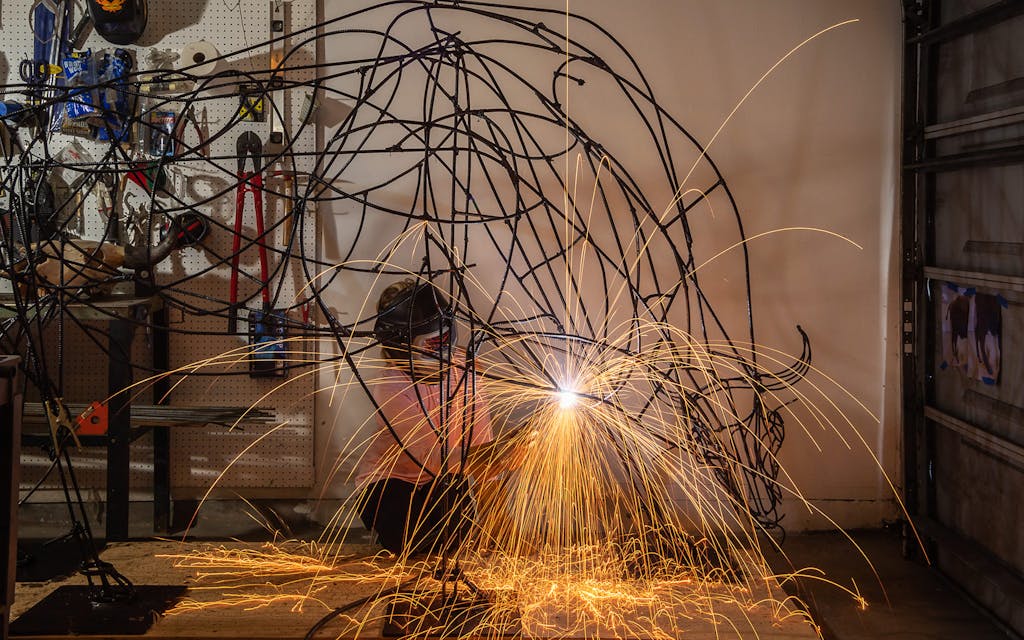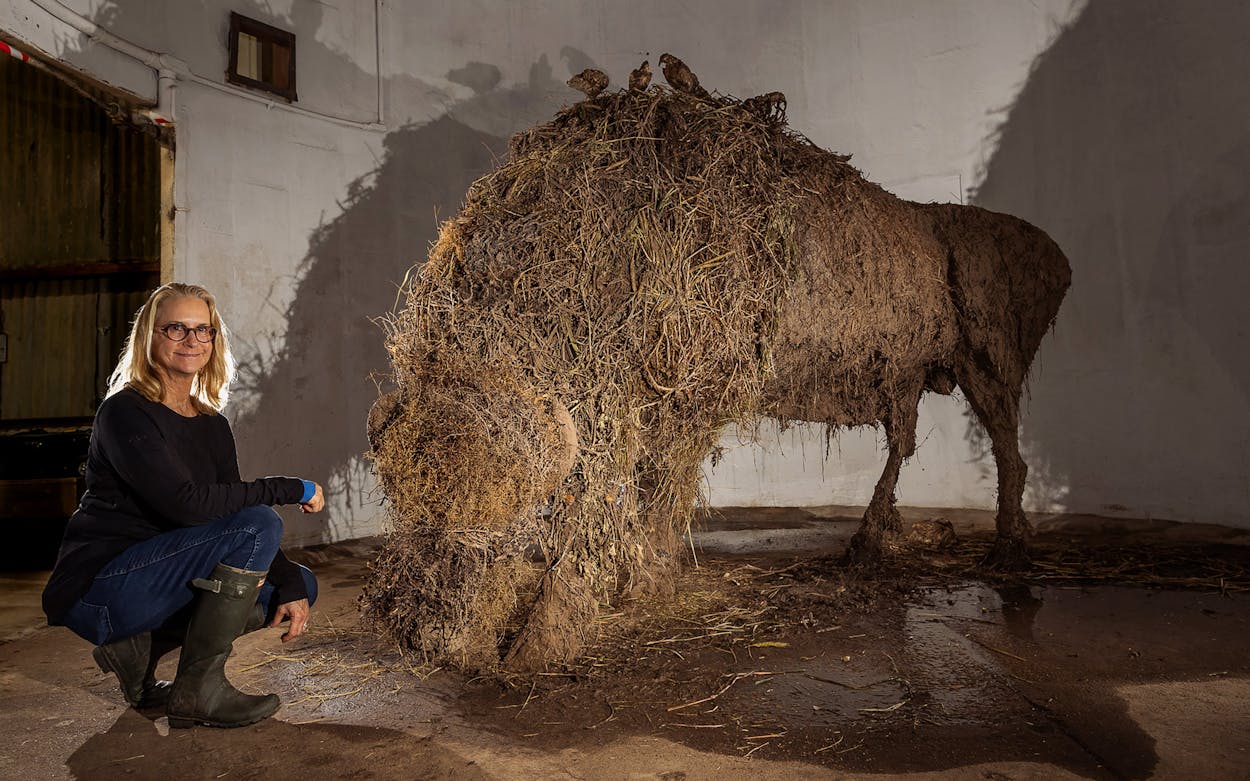As recently as two hundred years ago, surviving wild herds of American bison roamed as far south through Texas as the state’s coastal prairie. They had been a keystone species from Canada to Mexico for millennia, and their grazing, pooping, and wallowing helped build fertile soil and supported many other species, including migrating birds.
Artist Cindee Klement has packed that story into Endangered Knowledge: The Soul of Humus, a life-size, eight-hundred-pound replica of a grazing male bison with a hide of clay topsoil and a shaggy coat of locally sourced native grasses, seeds, and pods. Created for last fall’s Sculpture Month Houston biennial, the piece remains serendipitously corralled deep within the Silos at Sawyer Yards as a companion to a new, climate-themed show, “Blue Norther,” which is on view through March 26.
As often happens with her large-scale works, Klement created Endangered Knowledge without planning where she would put it when the first show ended in December. The sculpture is about eleven feet long by six feet high, but if she were to worry beforehand about how to store her monumental sculptures, she would never have the courage to make them, she says. The hive of dark, dank, and cylindrical silos, built in 1960 to store rice within a Riviana Foods complex near downtown Houston, is an unusual setting for land art. It’s also weirdly appropriate for Klement’s sculpture, since the building is a relic of industrial agriculture, a symbol of the large-scale land practices that have depleted the earth’s soils.
In her artist’s statement, Klement calls historic bison herds the first “farm equipment” and “massive roaming composters.” Her beast appears to have left a trail of dung through two of the silos. She hauled the dung to Houston from Roam Ranch, a multispecies, regenerative agriculture operation near Fredericksburg she has visited frequently to study bison and experience hands-on time with the animals. She had the dung bronzed, to both emphasize its importance and eliminate the smell. The piece also includes several bronze sculptures of birds, whose forms Klement built from seeds, grass, and wax. She depicts the birds pecking at the dung and perched on the bison’s shoulders to suggest the symbiotic relationships that are still apparent at places such as Roam Ranch, where red-winged blackbirds, meadowlarks and cattle egrets coexist with the livestock. Birds eat seeds in the dung, pick pests from bison coats, and using the animals’ hair to build strong nests, she explains.

Klement also wants to remind viewers that the ground under their feet is living soil. Don’t think of it as “dirt,” which is what gets tracked into your home on the bottom of your shoes. Healthy soil contains complex webs of microorganisms essential to life. When bison roamed across Texas, the state’s coast held about 6.5 million acres of prairie wetlands whose soil sequestered carbon and supported deep-rooted plants that absorbed stormwater, also providing habitat for many migratory species. Human development has wiped out all but one percent of that ecosystem, but Klement is no fatalist. Even Houston’s vast urban environment could be rebalanced if more residents thought of their yards as pocket prairies, she maintains.
“I want people to see that we can regenerate Houston’s landscape,” she says. “I don’t think there’s anything more important I could be doing with my life.”
One of Klement’s largest previous works was a lacy hanging sculpture about native bees, and at Houston’s Lawndale Art Center, she has converted a small, conventional yard into a garden of native plants. Building Endangered Knowledge turned into a project of more epic proportions than she expected. “I really got into that living soil in a big way,” she says. She’s chuckling now, but it wasn’t so funny last August. Working in her un-air-conditioned studio/garage, she had finished welding the armature to create the bison’s shape and covered it with a skin of stainless steel lath (the mesh that tile layers need to support mortar). She was about three days into the process of filling the structure with mud and grass when she pricked her right thumb on the sharp metal lath. It was just a pinprick, but two unknown bacteria—most likely from the clay—found their way into her bloodstream. “It was indigenous soil I sourced from people that provide fill for construction sites,” she says. “It’s one hundred percent clay, which I really love, because clay is the best dirt for absorbing carbon from the atmosphere.” Her skin was closed by the time her thumb, then her arm, turned red, so she required surgery. The wound had to be reopened and cleaned every other day for a week, and Klement had to keep her hand above her heart for two more weeks.
Meanwhile, the show was about to open. She had the sculpture moved to the silos unfinished, along with the rest of her materials. Her son flew home from Minneapolis for a day to help, but she also worked one-handed (and even using her feet at times) to push the clay and grass materials into the lath. Hauling five-gallon buckets of the clay, which weighed forty pounds before she added the necessary water, she tore her good shoulder. “It was a labor of love for sure,” she says. “And maybe insanity.”
Klement will have to find another home for her bison soon. She hopes to place it for a while, as is, inside one of Houston’s office buildings. (She thinks it would be a perfect art statement for an oil company mindful of carbon sequestration.) Ultimately, she wants to install Endangered Species permanently near Buffalo Bayou. “My long-term dream is that it will be cast in bronze and put in the water, so people will think about [that relationship] to our soil,” she says. “Having the downtown skyscrapers behind it would create tension, as opposed to putting it in a prairie somewhere, where it’s just another animal.”






